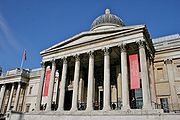 |
This is a file from the Wikimedia Commons. Information from its description page there is shown below.
Commons is a freely licensed media file repository. You can help.
|
Summary
| Artist |
Gerard van Honthorst (1590–1656)   |
 |
| Alternative names |
Gerard Honthorst, Gerard Hermansz. van Honthorst, Gerardus Honthorst, Gerrit van Hondhorst, Gerrit Honthorst, Gerrit van Honthorst, Gherardo Fiammingo, Gherardo della Notte, Gherardo delle Notti, Gherardo Delle Notti |
| Description |
Dutch painter, printmaker and ornamental painter
|
| Date of birth/death |
14 November 1590 |
27 April 1656 |
| Location of birth/death |
Utrecht (city) |
Utrecht (city) |
| Work location |
Utrecht (city), Rome (1610–1620), Utrecht (city) (1620–1628), London (May 1628-December 1628), The Hague (1637–1651), Utrecht (city) (1652–1656) |
| Authority control |
|
|
| Title |
Elizabeth Stuart, Queen of Bohemia |
| Description |
Elizabeth Stuart (1596 - 1662), known as the 'Winter Queen', was the eldest daughter of James I of England. She married Frederick, the Elector of the Palatinate, in 1613. He accepted the Bohemian crown in 1619, and was expelled from Bohemia in the following year. They lived in exile in Holland from 1621 onwards. She returned to England in 1661, and stayed in the London house of the 1st Earl Craven. In the following year she moved into Leicester House in Leicester Square where she died a few weeks later on 13 February. The picture was painted during the Queen's exile in Holland, ten years after she had been widowed, and may have been commissioned to mark this anniversary. She is shown as a grieving widow, wearing black with very few pieces of jewellery, notably the pearl earrings which had been given to her by her husband. She holds a stem in her hand on which there are two roses, one healthy and one wilted, a symbol of her widowed state along with the black ribbon on her arm. The dog can be interpreted as a symbol of fidelity.
|
| Date |
1642 |
| Medium |
oil on canvas |
| Dimensions |
205.1 × 130.8 cm (80.7 × 51.5 in) |
| Current location |
National Gallery   |
 |
| Native name |
National Gallery |
| Location |
London |
| Coordinates |
51° 30′ 30.96″ N, 0° 7′ 41.88″ W |
| Established |
1824 |
| Website |
nationalgallery.org.uk |
| Authority control |
|
|
| not on view |
| Accession number |
NG6362 |
| Credit line |
1965: bequeathed to National Gallery, London by his descendant, Cornelia, Lady Craven
|
| Inscriptions |
Signature and date on the pedestal behind Elizabeth: GHonthorst 1642 - GH in monogram
Name of sitter left: Queen of Bohemia - added by a later hand
|
| Source/Photographer |
The National Gallery London |
Licensing
This is a faithful photographic reproduction of an original two-dimensional work of art. The work of art itself is in the public domain for the following reason:
| Public domainPublic domainfalsefalse |
 |
This work is in the public domain in the United States, and those countries with a copyright term of life of the author plus 100 years or less. |
|
This file has been identified as being free of known restrictions under copyright law, including all related and neighboring rights.
|
The official position taken by the Wikimedia Foundation is that "faithful reproductions of two-dimensional public domain works of art are public domain, and that claims to the contrary represent an assault on the very concept of a public domain". For details, see Commons:When to use the PD-Art tag.
This photographic reproduction is therefore also considered to be in the public domain. Please be aware that depending on local laws, re-use of this content may be prohibited or restricted in your jurisdiction. See Commons:Reuse of PD-Art photographs.
|
File usage
The following pages on Schools Wikipedia link to this image (list may be incomplete):
This file contains additional information, probably added from the digital camera or scanner used to create or digitize it. If the file has been modified from its original state, some details may not fully reflect the modified file.
Wikipedia for Schools was collected by SOS Childrens Villages. SOS Children's Villages believes education is an important part of a child's life. That's why we ensure they receive nursery care as well as high-quality primary and secondary education. When they leave school, we support the children in our care as they progress to vocational training or higher education. Try to find out how you can help children in other countries on our web site.





